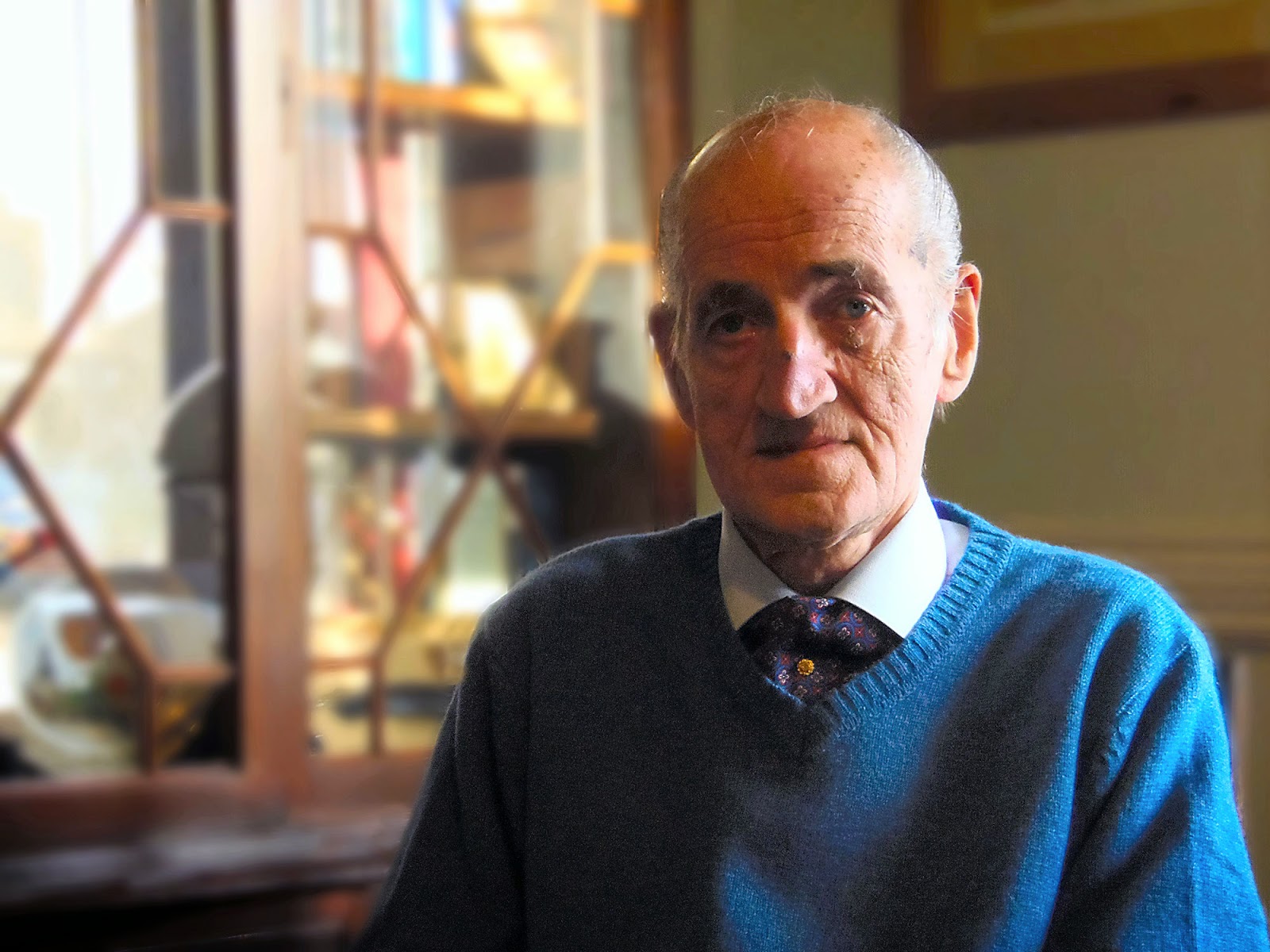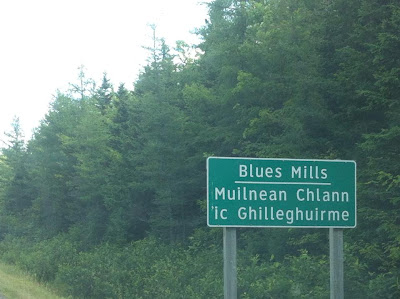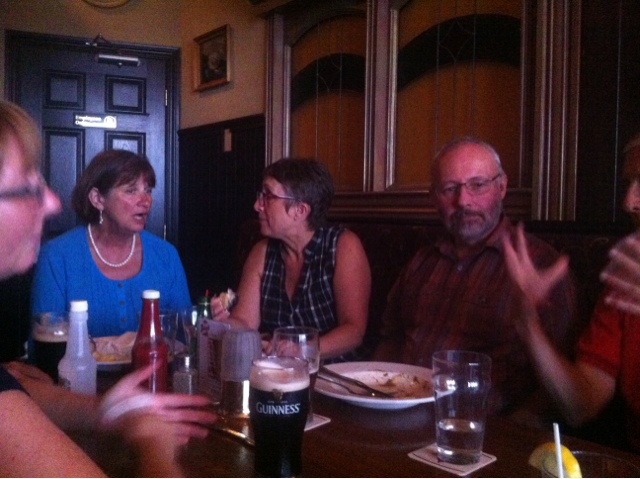IAIN A DHÀ IAIN #2
Assynt is one of those areas which seems somehow to have escaped the academic eye. When it comes to the far north of Scotland, you can start in the south of Rosshire and work your way up, finding most dialects covered by a monograph or a dictionary or a collection of some kind. Only Assynt and Caithness –ironically the two areas which initially interested me because of my family connections- have been left unexamined. I am currently going through the Gaelic Linguictic Survey entries for south Caithness with a fine-toothed comb and finding some very interesting features, especially in comparison with neighbouring dialects. Houston, we have an isolate! Other than that, Caithness will prove a difficult one given the lack of supplementary poetry, song or vocabulary, despite the bonus of 126 specifically dialect entries in Dwelly!
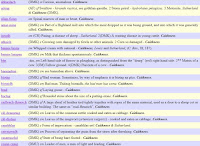 |
| Dual·chainnt Ghollaibh an Dwelly |
A great bonus for areas not covered by monographs is the Survey of Irish Dialects’ entries for the Scottish section. From Loch Carrann (Lochcarron) up, the northern dialects are covered by the SID, Ternes’ volume on a’ Chomraich (Applecross), Wentworth’s astounding work in Geàrr·loch (Gairloch), the terrific little book on a’ Chòigeach(Coigeach) dialect by Domhall Uilleam Stiùbhart (Donald William Stewart) and co, the SID again in Assynt and Seumas Grannd’s coverage of MacKay Country with his delightful dictionary. On the east coast, we have Watson’s fascinating study of Easter Ross Gaelic and the rightly world-famous investigation into East Sutherland Gaelic by my friend of some 6 years now, Nancy Dorian. There’s a lot of great material to work from for potential revival purposes. But from the perspective of the revivalist, will that be enough? If not, what’s missing?
Kenneth Jackson’s insistence on local parentage for all informants involved in the Gaelic Linguistic Survey was a stroke of utter genius. It means that we have as complete and as reliable a picture as can possibly be imagined -in a Highlands now so dreadfully deprived of dialect speakers- of how native Gaels sounded. In terms of what they said, Jackson’s attitude to word geography left a lot to be desired. The subject appears to have been almost looked down upon because of the unpredictability of the results but for me this simply betrays the cloistered lifestyle of the über-academic. The fact of the matter is that for the person on the street, it is words and their variety that capture the imagination, rarely whether someone said /a/ or /ɛ/ or /
əɣ/ or /
əv/. I mean it’s great to possess this information and we should be mighty glad to have it as
part of the picture but over and above that, no-one in their right mind gives a flying phoneme. My experience is that it is only people who have been shut away from the real world their entire lives in universities who believe these concerns to be remotely important. So while phonologists and phonemecists were fighting their fiddly little esoteric battles in the corridors of imagined power, we were losing dozens upon dozens upon dozens of precious words for things
,which will never be regained.
A-CHAOIDH.Bheil sibh ga mo thuigsinn? (Are you understanding me?)
A-CHAOIDH! (EVER!).
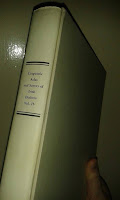 |
| SID Volume IV |
|
I must admit, I adore listening to scholars discuss the finer points of lingistics; I could pass hours at it. In fact I have several friends -they know who they are!- whose knowledge astounds me and to whom I regularly go for all manner of advice, but c’ mon down to brass tacks with me folks, Scotland has been putting the cart squarely before the horse for the last 50 years at least. Since the rumblings of the revival began, we have bent over backwards to keep up with the Whittingtons, establishing a university, drafting all sorts of rules and regulations, insisting that railway station signs in the middle of Lothian are in Gaelic, putting quantity squarely before quality in terms of speakership, and leaving old people who didn’t come from Skye or the Western Isles, whose dialect didn’t “fit”,to quietly pop their clogs in ignominy while the hallowed, well-funded halls of esoteria buzz with essential activity. All of the above-mentioned things had their place, some of them a very large and important place in fact, but I can’t help thinking that while the bone was being polished to a sheen worthy of the British establishment, the marrow was yet being sucked out from within.
I’m getting to my point in these blogs by the way, don’t worry… I do have a solution, and it ain’t got sh*t to do with suits, side-partings and seminars. It’s irreverent, old-fashioned and very cheap. Read on.
–
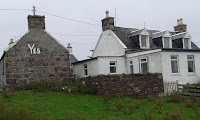 |
| STILL YES: taigh ann an Asaint |
Having scribbled away into my notebook for a good 15 minutes, I looked up at the sky. It was dimming down and if I didn’t want to be hitting Dornie in the dark and missing my dinner, I’d need to get moving. I scoured my brain for anything else that was said, pulling bits I’d forgotten from the beginning of the conversation with Iain back to mind and writing them down at the end. Iain had long since closed the door and got back to enjoying his Sunday rest as I turned the car around and set off.
His directions took me over a different road or two and I drove for what seemed like longer than it should have been before hitting a gentle brae between the moors with their scattered houses which scooped itself back out of a hollow to arrive at the house of Iain MacIllEathain (Iain MacLean). It was a neat-looking grey number, clearly kept in decent condition by its owner, with a nice garden round about, but nothing too fancy. The sea was visible from the road and the air was cool and laced with moisture. I went through the gate, imagining what Iain looked like, mindful as always of disturbing anyone unnanounced in these days of obsessive organisation.
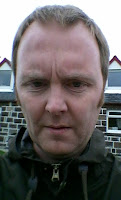 |
| Robh Iain aig an taigh? |
I grew up with people coming in and out of the house completely unannounced. You wouldn’t know someone was visiting our place at Rubh’ Bàn(pale point), just north of Taigh na Bruaich (House of the Bank) until they were already upon you, in the door and practically with their arse in the seat waiting for their coffee before you had any idea they’d arrived. Nowadays, if you haven’t Booked someone in the Face, or Grammed them Instantly, or Snapped their Chat, you’re being exceedingly rude. Turn up without texting ahead? How very dare you!
I’m very rarely apprehensive in the Highlands, but this was Sunday, and Assynt was rather a religious neck of the woods not that long ago. I entered the porch, the front door being open, and saw a nimble grey-haired man in his 70s scampering up the stairs of the house. I chapped the glass panel in front of me before he could escape and he peered quizzically through the balustrade, trying to work out if he recognised me.
I stepped back from the porch, not wanting us to have to vye for space within it should he see fit to emerge. And so it was I met with Iain a Dhà (Iain #2).
Iain? He padded back down the stairs and loomed up to the glass with a pleasant if confused expression. Nach gabh sibh mo leisgeal (Won’t you accept my excuse ie excuse me). Thuirt Iain the Gate rium gum bu chòir dhomh tighinn gur faicinn (Iain the Gate said I should come and see you) I said as Iain tugged the front door open.
Ó Iain, tha mi tuigsinn (Oh Iain, I understand).
Thuirt e gur sibhse an duine as fheàrr air son Gàidhlig an àite (he said you were the best man for the Gaelic of the place ie local Gaelic).
Ó an duirt gu dearbh? says MacIllEathain, amused. Có às a tha u? (where are you from?)
Arra-Gháidheal (Argyll). Chaidh mo thogail shìos taobh Dhùn Omhann, ann an Taigh na Bruaich (I was brought up down Dunoon way, in Tighnabruaich).
Ó tha fhios ‘am (oh I know [what you mean]). Shìos an sin, seadh (Down there, yes). Bheil holiday agad an seo? (have you a holiday here?) There must not be that many Argyllmen randomly showing up on Iain’s doorstep these days.
Chan eil. Shiubhail mo mháir ‘s chaidh a tiodhlacamh an Gollaibh ‘s cha robh mi air son a dhol air ais a dh’obair anns an uair (No. My mother traveled ie passed away and was buried in Caithness and I didn’t want to go back to work immediately) ‘s mar sin, bha mi los feuchainn an robh duine sam bith thathast ann an Dùthaich MhicAoidh ‘s Asaint ‘s Sgireachd Ròis aig an robh Gàidhlig an àite (and so I was for seeing [lit. trying] if there was anyone left in MacKay Country, Assynt and Ross who had the local Gaelic).
Ó gu dearbh? (oh really?) Chan eil móran Ghàidhlig an seo a-nis (there’s not much Gaelic here now). Tha i air bàsachadh air fad ann an seo(She’s completely died here). It could bring a tear to a glass cabinet nevermind an eye, this story, heard as it is from one end of the mainland to the other. An ann à Barraigh a tha a’ Ghàidhlig ads’ (is it from Barra your Gaelic is?). That’s a reasonable assumption if you’re from Assynt as my dialect must sound a little outlandish.
Ha-ha, chan ann, ‘s e dual·chainnt an àit’ ás an táini’ mi ‘hé tha seo. Gáidhlig Arra-Gháidheil (no, it’s the dialect from where I come from this, Argyll Gaelic).
Seadh, ‘s e mac-samhladh de Ghàidhlig nan Eilean a th’ agad (Aye, it’s the exact match of the island Gaelic you’ve got). I’m chuffed enough with that, despite it being out by a good couple of miles… mac-samhladh… the likeness’ son; lovely to hear that expression used. Bha mi seòladh chun gu leòr de na h-Eileanan dair a bha mi sa Mherchant Navy (I was sailing to plenty of the islands when I was in the Merchant Navy).
Gu dearbh? (Indeed?) It suddenly hit me as always that I should check and make sure I wasn’t keeping Iain back from his normal activities. Bheil sibh trang an ceartair, robh sibh am beachd itheamh no gas, no a’ bheil cothram againn bruidhinn tacan? (Are you busy just now, were you intending on eating or anything, or have we an opportunity to speak a wee while?)
Ó tha. Ó, chan eil mi trang an-dràst’, chan eil (Oh yes. Oh I’m not busy just now, no). Result!
‘S e an rud a bh’ ann, bha mi ‘g iarraimh beagan cheistean a chur air muinntir an àite seo a thaobh ghnothaichean a theireamh sibh (The thing was, I wanted to put a few questions on the people from here in terms of things you would say).
 |
| Chan eil móran ann an Dwelly ás Asaint |
Tha mi tuigsinn (I understand).
Bha mi feòraich de dh’Iain, dé theireamh sibh ri na corragan? (I was asking Iain, what would you say to the fingers?). An robh rann sònraichte ann an Asaint orra? (Was there a special verse in Assynt on them?) Iain MacIllEathain looks at me with complete recognition, as if he knows exactly what I mean:
Seadh, bha ainm ac’ air a h-uile corrag, ach chan eil fhios am·as dé na rainn a bh’ ac’ a-nis (Yes, they had a name on every finger, but I don’t know what the rhymes they had were now). Oh ye booger, I thought I had them there. Having gotten home and finally sat down with my notes to write this blog six months later after a hard winter trying to make ends meet, I have the opportunity to look up the Irish Dialect Survey and much to my disappointment, the finger names are not listed. It appears as if the people of Assynt referred to them as meòirean and to a single one as a miar, but there are only the following individual names for the fingers, the last two of which strike me as Beurlachas (Gaenglish): òrdag (little hammer), ____ (no entry), ____ (no entry), miar an fhàinn’(ring finger), miar beag (little finger).
Nis, na bh’ againn an Arra-Gháidheal, ‘s e seo (now what we had in Argyll was this): òrdag (little hammer), corragag (little finger), mealla-fada (long lump), mac an lùba (son of the pinkie), lùdag (pinkie). I had gotten this from Ràibeart Mac a’ Bhiocair (Robbie MacVicar), our last native speaker, and for all my lack of formal training have gone over it every time I’ve seen him since to make sure I’ve got the right version. Apart from a little vascillation over whether it’s lùdag or lùbag, I get the same thing every time, with very little prompting.
Ó, nis, lùbag, bha sin againn (oh, now, lùbag, we had that) Given my experience with Robbie, it’s interesting that Iain has said this word with a b rather than a d… ach chan eil cuimhn’ am·as air (but I don’t remember on)…
…air an fheamhainn sa mheadhan? (on the ones in the middle?) I added.
Chan eil, chan eil (I don’t, no.) Och chan eil feadhainn Ghàidhlig ann a-nis ann, chan eil (Oh there’s no Gaelic ones here whatsoever, no). Chaochail a’ chuid mhór aig an robh Gàidhlig (The biggest lot with Gaelic changed ie died).
Feumaidh gu robh gu leòr a Ghàidhlig ga bruidhinn bho cheann da fhichead bliana? (there must have been plenty of Gaelic spoken 20 years ago?) I venture, keen to find out more about the shift in Assynt.
Och seadh, tha cuimhn’ am·as air thoiseach, bha Gàidhlig ga bridhinn sa h-uile taigh (oh aye, I have a memory at the beginning [of Iain’s life], Gaelic was spoken in every house).
Sa h-uile taigh, seamh (in every house, yes). This is painfully familiar.
A-nis, chan eil gin den fheadhainn shuas Loch an Inbhir ach mi ‘hìn ‘s Iain a bhridhneas Gàidhlig, chan eil (Now there aren’t any up Lochinver but myself and Iain that speak Gaelic, no). Chan eil gin ann (There aren’t any).
 |
| “poca-salainn” ann an Asaint |
Nise, ceist eile a chuir mi air Iain ach cha robh fhios aige·san (Now, another question I put on Iain but he didn’t know). Thuirt e nach do bhruidhinn e mun cuairt air a leithid bhon a bha e na bhalach! (He said that he hadn’t spoken about the like of it [in Gaelic] since he was a boy!). Dé theireamh sibhse san dùthaich seo ri spider?
Ó, after a moment’s thought,chanainn “poca-salainn”, ach chan eil mi glé chinnteach (Oh, I’d say poca-salainn [salt-bag], but I’m not quite certain). That’s the very boy though, the very boy!
Feumaidh gum bitheamh e car coltach ri sin (It must be that it would be fairly similar to that), bhon sin a th’ aca an Sgìreachd Ròis co-thiù (for that is what they had in Ross-shire anyway)… bhon a tha a thòin car geal (because his bum is somewhat white ie salty-looking).
Och seadh (oh yes). Gu dearbh feumaidh (indeed it must), sin a bhiodh an ùis co-dhiù (that’s what would be in use anyway). It seems just discussing it a little further has affirmed Iain’s conception of whether the word is right or not. Sometimes it’s dicy to speak further on it, in case an erroneous response is set in stone, but in this case Iain’s word was spontaneous without prompting and can be taken as representative of Assynt. A check with the SID entry and we get pocan-salainn, a diminutive version, and interestingly lacking pre-aspiration. Och, tha móran ann (oh there are lots) says Iain continuing on:
Na h-eòin bheag’ an sin; stonechat a chanas iad sa Bheurla. Nach e “clachair” a bh’ ac’ orr’? (The little birds there, “stonechat” they say in English, isn’t it clachairthey have on them?) If only I had a couple of days up here to get into all of this…
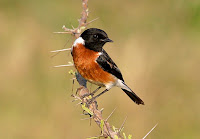 |
| “clachair” |
Och sna lathan air dol seachad, bha ainm ac’ air a h-uile dithean ‘s a h-uile biuthach (oh in the days gone by, they had a name on every flower and animal) I reminisce, as if I had been there. That makes Iain think of something amusing.
Rud a bha mi smaoineachadh air (a thing I was thinking on) he says, dé a’ Ghàidhlig a th’ ac’ air umbrella? (What’s their Gaelic for an umbrella?).
Sgàilean, cha chreib mi (Shade, I reckon), quoting the standard tongue. Iain nods, but is clearly in thought. The word doesn’t seem too familiar to him.
Tha beagan diofar eadar a’ Ghàidhlig ann an Leódhas agas Uibhist (there’s a bit of a difference between the Gaelic in Lewis and Uist) says Iain, gesticulating towards the sea as if to bring back to mind that there are islands out there to the west.
Ó tha, I agree, theirinn gu bheil a’ Ghàidhlig an seo (I’d say the Gaelic here), gu bheil i nas coltaiche ri Gàidhlig Leódhais na tha i ri na h-Eileanan eile ge-tà (that it’s a little more similar to Lewis Gaelic than it is to the other Isles). I’m keen to find out if Iain a Dhà thinks so too.
Ó tha gu dearbh, ó tha (oh yes indeed, oh it is), he replies. Tha i nas fhaisg’ air a’ Ghàidhlig a th’ ac’ an sin (It is closer to the Gaelic they have there). Ach na bha ‘d a’ bridhinn an seo, ‘s e seòrsa Gàidhlig eile bha sin (But what they were speaking here, it was a different kind of Gaelic). It’s lovely to hear that self-awareness, that distinctness acknowledged by someone who is still a source of it himself. Iain’s kind are on the way out on the mainland, and very, very few people seem to consider it loss enough to get off their backsides and put on the brakes. Native Gaelic in the Scottish mainland will be dead in 30 years. TOPS. Are we ready to admit that to ourselves? If it doesn’t hurt you to think of it, wake the heck up people.
Nise, dé bha sibhse ‘g ràdh ann an seo(Now, what were you saying here) air –mar a their ead anns a’ Bheurla- how are you? (on –as they say in English- “how are you?”) Dé a bh’ agaibh·se air sin? (What did you have on that?). I’m always curious about this one. We once produced a map here at DROITSEACH showing where the different phrases were used and I’m keen to settle a debate raised by someone who was sure that cionnas a tha u? was used all the way from Gairloch north.
Ó, “ciamar a tha u?” Iain says without hesitation.
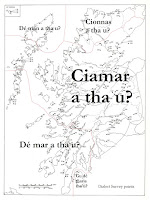 |
| “ciamar a tha u?” |
“ciamar a tha u?”? I repeat, slightly surprised. Bhon, daoine shuas taobh Dhùthaich MhicAoidh, their ead “cionnas a tha u?” (Because, people up MacKay Country way, they say cionnas a tha u?) Ach ‘s e “ciamar” a bh’ agaibh ann an seo?(But it’s ciamar that you had here?)
Ó ‘s e (oh it was).
Agas ‘s e “ciamar” a bh’ aig ur pàrantan cuideachd? (And it’s ciamar that your parents had too?)
Ó gu dearbh, ‘s e (oh indeed, yes). That’s that one beyond any doubt.
Tha sibh ga mo thuigsinn a-nis, nach eil? (you’re understanding me now, aren’t you?). I often try to speak the dialect of the older generation if I’m with them to make sure I come over ok, but in this case I wasn’t too sure what the dialect of Assynt was like. Unlike the MacKay Country where I can converse quite freely in the local patois, here I thought while I’d better round out some obvious Dalriadisms, I may well just confuse matters by starting to make guesses about what might be more comprehensible. Sure, they’ll say caninstead of abair (say) and obvious northern things like that, but I didn’t want to go out on too weak a branch on a first visit.
Och tha, tha glé cheart a-nis (oh yes, just fine now). I’m off the hook!
Ach co-thiù, cha robh mi ach dol seachad(But anyway, I was but going past), tha mi dol sìos thun an Dòrnaidh a-nochd (I’m going down to the Dornie tonight).
Ó, an Dòrnaidh, tha mi tuigsinn (oh the Dornie, I understand).
Thuirt mi ri Iain, an ath uair a bhitheas mi dol seachad (I said to Iain, the next time I’m going past), thig sinn uile comhla ‘s bruidhnidh sinn beagan Gàidhlig (we’ll all come together and speak a little Gaelic).
Ó seadh, glé mhath, nì sinn sin ma-thà (Oh yes, very good, we’ll do that then). There’s no sense of imposition about this idea in Iain’s voice whatsoever, I can tell he’d be more than happy to sit with a cup of tea or a dram and blether in the old tongue. Uair sam bith a tha u dol seachad, trobhad a-staigh (anytime you’re going past, come on in). And once again. There it is!
Bithidh sin gasta ma-tà (that’ll be splendid then). I smile as we back away from the house, still chatting.
Tha fliuch! (It’s wet!) adds Iain, as we stand at the gate getting lightly spat on.
Tha, bha fliuch fad an t-Samhraimh (Yes, it was wet throughout the summer). Bha dona([It] was bad).
Ó gu dearbh, bha móran uisg’ ann (oh indeed, there was a lot of water ie rain). Bha sneachd ann cuideachd.(There was snow too). Cha do thiormaich am mòin’ a bh’ agam son an tein’ gu ceart (The peat I had for the fire didn’t dry out properly). Uisg’ uisg’ uisg’!(Rain rain rain!).
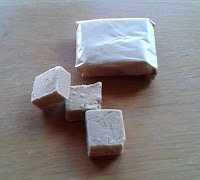 |
| clàr-siùcair air son nan Gàidheal |
Och seamh (oh aye), ‘s e dìle-bhàit’ a bh’ ann o cheann gu ceann na mìos, an July mar a their ead (there was a drowning flood from head to head of the month, in July, as they say). It is not common for dialect speakers to know the months of the Julian calendar, as it was not used until relatively recently. Nise, rud a th’ agam an seo (now, the thing I have here), reinn mo bhean beagan clàr-siùcair son na h-uile duin’ a chì mi shuas an seo (my wife made a little tablet for everyone I see up here).
Dé a th’ ann? (What is it?)
Tablet.
Ó glé mhath (oh very good).
Tha uarraidh milis (It’s awfully sweet).
Móran siùcair ann! (Much sugar in it!)
Dìreach (Exactly). Nise, tha mi dol a thogail dealbh bheag dhinn an seo leis an taigh (Now I’m going to lift a small picture of us here with the house). Bheil sin ceart gu leòr? (Is that alright?)
Och tha (oh yes).
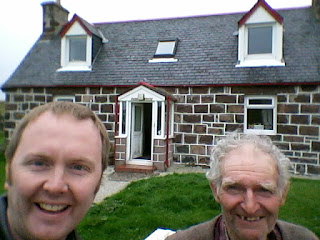 |
| Àdhamh Ó Broin agas Iain MacIllEathain ann an Asaint |
Innsidh do mo chlann gun do thachair mi air Gáidheal, Iain MacIllEathain (I’ll tell my children that I met a Gael, Iain MacLean), shuas taobh Asaint (up Assynt way). The kids always like to hear that there are other people in other places who speak their language.
Ha-ha, sin agad e! (there you have it!).
And with that, I took my leave, feeling genuinely buoyed up by this encounter, but more sure than ever of what needed done. Seven months later and that feeling has only grown. Both Iains, despite the protestations of Iain #1 to the contrary, were very fluent. Coupled with the vocabulary contained in the Survey of Irish Dialects, this means that the local dialect is absolutely capable of being rescued in the nick of time. All we lack is the will. Or do we? Is there actually someone out there with connections to the place, who has learned enough Gaelic to take the work on, who could become a TOSGAIR for the area and spend a few hours a week learning to speak like the two Iains? Could their tale and that of their language be prevented from its end when inevitably sometime over the next 20-odd years, they are parted from this world? This may seem like a very personal way to speak about two people I barely know, but what choice do I have but to take on this responsibility when very few others will? Don’t tell me that local lore, vocabulary and accent are important and then do bugger-all about it. It’s either worth something, or it’s not. There is no in between.
 |
| Asaint nan Loch ’s nan Creig |
And so I left Assynt feeling that while I had spent barely three hours there, I had got under the turf, down to the peat of it a little. The Land of MacLeod lived yet as it was, but was barely hanging on by the skin of its teeth. I had dug under the myth of Neil the Traitor and I had heard the tongue of his people, who for better or for worse had stuck it out in Assynt ever since, through Clearance, poverty and war. The whole experience had been very moving.
Dair a bhitheas mi ‘n Asaint (When I am in Assynt), as Rob Donn MacAoidh (MacKay) put it, Is Leòdach mi (I am a MacLeod). Whatever area I enter, I become one of the people. I never feel like I am an outsider because I value deeply all that every nook and crannie of the Scottish Highlands has to offer and I can’t help but take the demise of its culture as a personal injury. My journey took me back across to Lochinver and I was struck by how rugged the land was, pocketed with wildly uneven lochs and hollows, puntuated vertically by jagged rock and bluff, green and grey and ginger with dying bracken under a film of kissing rain. This land is the physical expression of the language that our Iains speak and when these men cease to speak, the land will fall silent forever, another corner of the Highlands will go dark, its cultural life’s blood will cease to pump through local veins, will reach no more these extremities, withdrawing out to the Isles where it will meet a similar fate in little over 50 years, if we are not very, very, careful and more importantly, indefatigable in our determination to resist.
Monographs, dictionaries, manuals -however good- are but a single cornerstone, not a whole house.
Scholars, academics, researchers -however smart- must be as slaves to the wisdom of our elders.
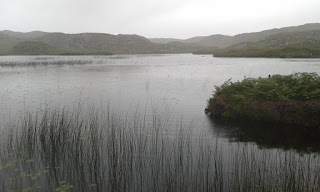 |
| Dair a bhitheas mi ’n Asaint, is Leòdach mi |
To putting the horse back before the cart, in the land of MacLeod and beyond, ur slàinte mhór!
–
“Beautiful gripping writing.
Should be a book, not just a blog”
Alastair McIntosh













